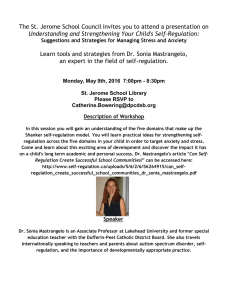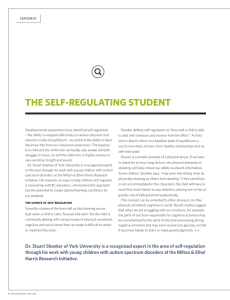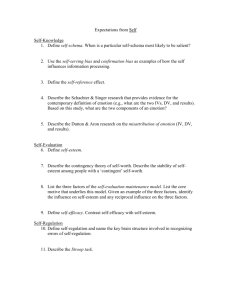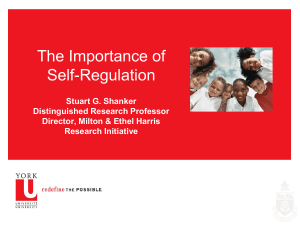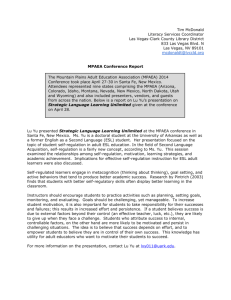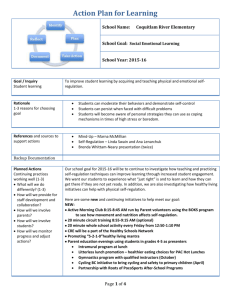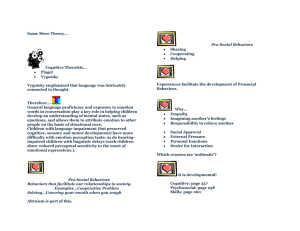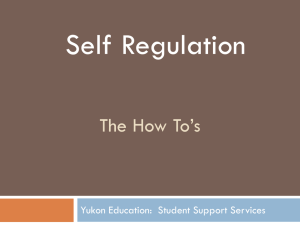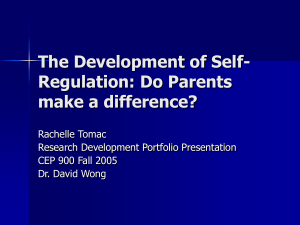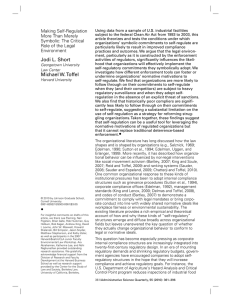session4
advertisement
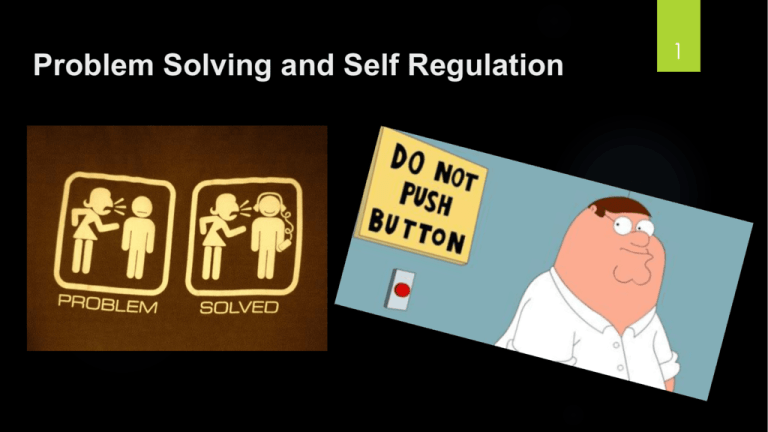
Problem Solving and Self Regulation 1 Today’s Learning Outcomes To understand problem-solving and selfregulation and their connection to communication and perspective taking. To gain practical strategies that support selfregulation and problem solving. 2 Overview of the day Introductions and ice breaker Define self-regulation and why it is important Ways to support self-regulation Activities Define problem solving and why it is important Steps to good problem solving Activities Connecting problem solving and self regulation to communication and perspective taking Quiz Evaluation 3 Introductions/Ice Breakers Choose one candy from the bowl Each colour represents on piece of information you will share: Red-favourite place on earth Green-dream job Blue-last movie you watched Other colours-anything you want to share 4 5 What is self regulation? “…the ability to do what needs to be done to be in the optimal state for a given situation,” (L. Kuypers, 2011). 6 Why is self-regulation so important? Within the last decade research has indicated that lack of self regulation early in a child’s life has broad reaching consequences, both medical and psychological, (S. Shanker, 2011). Possible consequences of lack of self-regulation. Autoimmune disorder Cancer Risky behaviour Obesity Cognitive problems Lack of academic success Internalizing problems Externalizing problems Cardiovascular disease 7 Stuart Shanker’s Five Domains of Self- Regulation 1. Biological: how you respond to stimuli at the biological level 2. Emotional: how you deal with strong feelings 3. Cognitive: how you process, store and retrieve information 4. Social: how you understand and respond to social cues 5. Prosocial: how you demonstrate positive skills like empathy 8 9 Biological Domain Biological: Indicators for Support Support Strategies The activity or • Difficulty sitting • Warnings for energy level in the still transitions nervous system. • Easily distracted • Sensory tools • Hyper alert available • Drumming 10 Emotional Domain Emotional: Indicators of Support Feelings and moods both negative and positive • • • Support Strategies Over excited • Intense frustration • Extreme fears • • Deep breathing Journaling feelings Social stories Modeling Cognitive Domain Cognitive: Indicators for Support Mental process such as memory, acquiring and retaining information • • • 11 Support Strategies Difficulty • shifting attention • Struggles with sequencing • impulsive behaviours Break down instructions Create a quiet work space Identify interests 12 Social Domain Social: Indicators for Support Assessing, understanding • and responding to social cues appropriately • • Social awareness is lacking Cannot read others Difficulty with cooperative play Support Strategies • • • Facilitate group activities Feeling games Mind reading games Prosocial Domain Prosocial: 13 Indicators for Support Social acceptance, • friendship, empathy and peer to peer interactions • Does not consider others feelings Too overwhelmed to read social cues Support Strategies • Modeling • Social stories • Empathy programs • Teaching perspective taking Activity: How do you self-regulate? Take a moment to think of things you do in a typical day to regulate yourself, in order to function and interact in a positive way. In what domains do you require the most selfregulation? Share with a partner 14 Self Regulation vs. Compliance Self Regulation A child recognizes the noise during assemblies raises his/her stress level causing agitation and excessive wiggling. They decide to wear ear plugs and bring a fidget toy to help calm themselves during noisy times. 15 Compliance A child is sent to the assembly without any tools, told to sit quietly or they will not be able to go out for recess. The child is even more stressed due to the added pressure of missing recess, but does their best to comply. Ways to Support Self-Regulation 16 Activity: 5 Point Scale 17 Activity: Zones of Regulation 18 19 What is problem solving ? “ a self-directed cognitive process by which a person attempts to discover adaptive ways to deal with problematic situations that happen in everyday life, (D’Zurilla and Nezu, 1982).” Why is problem solving so important? It is a critical skill that supports an individuals ability to self-regulate Our daily life is filled with both big and little problems through out the day. Good problem solving skills allows children to effectively make decisions with confidence and increase independence from adult support It is a skill the will transfer into all aspects of life as a child grows up 20 Steps to Good Problem Solving Most problem solving methods follow similar basic steps: 1. Identify the problem 2. Brainstorm solutions 3. Choose a solution (social behaviour maps should be used) 4. Try the solution 5. Decide if it worked. Consider next steps.. 21 Problem Solving Strategies 22 Activity: Modern Family Problem Complete the handouts after watching the video. 23 Putting it All Together 24 A good problem solver requires someone 1. 2. Who can clearly articulate their needs and emotions (communication) Who can self-regulate. This requires them to see various perspectives on a situation, including how they are perceived by others 25 Four Steps that bring the concepts together 1. Think about people and what they are thinking of me. Self regulate to keep others thinking accurately/positively. 2. Be physically aware of others and yourself. Self regulate to keep your body language open and calm. Look at the facial expressions of others and consider what yours are saying. Continued… 26 3. Use your eyes to consider what others might be thinking about. A problem solving strategy for understanding what people are thinking and feeling. 4. Use your language to connect with others and express yourself. Problem solving by verbally expressing your needs and wants and considering the response of others. 27 Skill Development: 4 Steps 1. Model-direct teaching Watching videos, read books, use social stories and scripts 1. Coach-practice skills with the student Role play, involve peer mentors Continued… 3. Reflect and Analyze Provide positive praise and constructive feedback Be specific and provide examples with your feedback 4. Maintain and Generalize Keep parents informed and involved Look for different settings to practice skills 28 29 Quiz! 10 minutes Closure 1.Summative Assessments 1.Evaluation 30 References Slide 5 31 L. Kuypers. (2011). The Zones of Regulation. San Jose, CA, Social Thinking Publishing. Slide 6 S. Shanker, retrieved October 16, 2014 from: http://www.beststart.org/events/detail/bsannualconf11/webcov/presentations/K3_Importance%20of%20Self-Regulation.pdf Slide 7 Education Canada, January 2014, retrieved from: http://www.cea-ace.ca/education-canada/article/foundational%E2%80%9Cr%E2%80%9D Slides 8-13 S. Shanker. BC Primary Teachers Association, Posted Nov. 10, Retrieved from: 2012http://www.bcpta.ca/wordpress/?paged=2. Slide 17 K. Buron. (2003). The Incredible Five Point Scale. Shawnee Mission, Kansas: Autism Aspergers Publishing. Slide 19 D’Zurilla and Nezu.Social Problem Solving. Retreived from: http://www.ub.edu/gdne/documents/sps_chapter_in_APA_book.pdf
